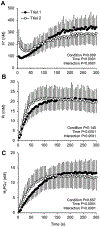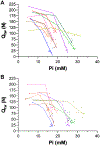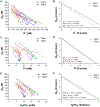On the role of skeletal muscle acidosis and inorganic phosphates as determinants of central and peripheral fatigue: A 31 P-MRS study
- PMID: 35593645
- PMCID: PMC9250628
- DOI: 10.1113/JP283036
On the role of skeletal muscle acidosis and inorganic phosphates as determinants of central and peripheral fatigue: A 31 P-MRS study
Abstract
Intramuscular hydrogen ion (H+ ) and inorganic phosphate (Pi) concentrations were dissociated during exercise to challenge their relationships with peripheral and central fatigue in vivo. Ten recreationally active, healthy men (27 ± 5 years; 180 ± 4 cm; 76 ± 10 kg) performed two consecutive intermittent isometric single-leg knee-extensor trials (60 maximal voluntary contractions; 3 s contraction, 2 s relaxation) interspersed with 5 min of rest. Phosphorus magnetic resonance spectroscopy (31 P-MRS) was used to continuously quantify intramuscular [H+ ] and [Pi] during both trials. Using electrical femoral nerve stimulation, quadriceps twitch force (Qtw ) and voluntary activation (VA) were quantified at rest and throughout both trials. Decreases in Qtw and VA from baseline were used to determine peripheral and central fatigue, respectively. Qtw was strongly related to both [H+ ] (β coefficient: -0.9, P < 0.0001) and [Pi] (-1.1, P < 0.0001) across trials. There was an effect of trial on the relationship between Qtw and [H+ ] (-0.5, P < 0.0001), but not Qtw and [Pi] (0.0, P = 0.976). This suggests that, unlike the unaltered association with [Pi], a given level of peripheral fatigue was associated with a different [H+ ] in Trial 1 vs. Trial 2. VA was related to [H+ ] (-0.3, P < 0.0001), but not [Pi] (-0.2, P = 0.243), across trials and there was no effect of trial (-0.1, P = 0.483). Taken together, these results support intramuscular Pi as a primary cause of peripheral fatigue, and muscle acidosis, probably acting on group III/IV muscle afferents in the interstitial space, as a contributor to central fatigue during exercise. KEY POINTS: We investigated the relationship between intramuscular metabolites and neuromuscular function in humans performing two maximal, intermittent, knee-extension trials interspersed with 5 min of rest. Concomitant measurements of intramuscular hydrogen (H+ ) and inorganic phosphate (Pi) concentrations, as well as quadriceps twitch-force (Qtw ) and voluntary activation (VA), were made throughout each trial using phosphorus magnetic resonance spectroscopy (31 P-MRS) and electrical femoral nerve stimulations. Although [Pi] fully recovered prior to the onset of the second trial, [H+ ] did not. Qtw was strongly related to both [H+ ] and [Pi] across both trials. However, the relationship between Qtw and [H+ ] shifted leftward from the first to the second trial, whereas the relationship between Qtw and [Pi] remained unaltered. VA was related to [H+ ], but not [Pi], across both trials. These in vivo findings support the hypotheses of intramuscular Pi as a primary cause of peripheral fatigue, and muscle acidosis, probably acting on group III/IV muscle afferents, as a contributor to central fatigue.
Keywords: exercise; intramuscular metabolic by-product; magnetic resonance spectroscopy; neuromuscular fatigue.
© 2022 The Authors. The Journal of Physiology © 2022 The Physiological Society.
Conflict of interest statement
Competing interest
The authors declare no conflict of interest.
Figures






Comment in
-
Insights into neuromuscular fatigue using 31 P-MRS.J Physiol. 2022 Jul;600(13):3011-3012. doi: 10.1113/JP283331. Epub 2022 Jun 10. J Physiol. 2022. PMID: 35687052 Free PMC article. No abstract available.
-
Exercise-induced metabolites and fatigue: can an inorganic phosphate breakpoint predict the rapid onset of peripheral fatigue?J Physiol. 2022 Aug;600(15):3391-3392. doi: 10.1113/JP283428. Epub 2022 Jul 6. J Physiol. 2022. PMID: 35751541 No abstract available.
Similar articles
-
Skeletal muscle bioenergetics during all-out exercise: mechanistic insight into the oxygen uptake slow component and neuromuscular fatigue.J Appl Physiol (1985). 2017 May 1;122(5):1208-1217. doi: 10.1152/japplphysiol.01093.2016. Epub 2017 Feb 16. J Appl Physiol (1985). 2017. PMID: 28209743 Free PMC article.
-
Skeletal Muscle Fatigue in Rats Is More Consistently Related to Increased Inorganic Phosphate Concentration Than Acidosis.Acta Physiol (Oxf). 2025 Aug;241(8):e70083. doi: 10.1111/apha.70083. Acta Physiol (Oxf). 2025. PMID: 40686424 Free PMC article.
-
Influence of blood flow occlusion on the development of peripheral and central fatigue during small muscle mass handgrip exercise.J Physiol. 2015 Sep 1;593(17):4043-54. doi: 10.1113/JP270424. Epub 2015 Aug 2. J Physiol. 2015. PMID: 26104881 Free PMC article.
-
The effect of metabolic alkalosis on central and peripheral mechanisms associated with exercise-induced muscle fatigue in humans.Exp Physiol. 2015 Apr 20;100(5):519-30. doi: 10.1113/EP085054. Exp Physiol. 2015. PMID: 25727892 Review.
-
Effects of older age on contraction-induced intramyocellular acidosis and inorganic phosphate accumulation in vivo: A systematic review and meta-analysis.PLoS One. 2024 Sep 25;19(9):e0308336. doi: 10.1371/journal.pone.0308336. eCollection 2024. PLoS One. 2024. PMID: 39321147 Free PMC article.
Cited by
-
Global trends and hot topics in electrical stimulation of skeletal muscle research over the past decade: A bibliometric analysis.Front Neurol. 2022 Oct 5;13:991099. doi: 10.3389/fneur.2022.991099. eCollection 2022. Front Neurol. 2022. PMID: 36277916 Free PMC article.
-
Unilaterally Induced Quadriceps Fatigue during Sustained Submaximal Isometric Exercise Does Not Alter Contralateral Leg Extensor Performance.J Funct Morphol Kinesiol. 2023 Jun 19;8(2):85. doi: 10.3390/jfmk8020085. J Funct Morphol Kinesiol. 2023. PMID: 37367249 Free PMC article.
-
The Dynamics of Locomotor Neuromuscular Fatigue during Ramp-Incremental Cycling to Intolerance.Med Sci Sports Exerc. 2025 Apr 1;57(4):700-709. doi: 10.1249/MSS.0000000000003414. Epub 2024 Mar 11. Med Sci Sports Exerc. 2025. PMID: 38465870 Free PMC article.
-
Blood-Based Markers for Skeletal and Cardiac Muscle Function in Eventing Horses before and after Cross-Country Rides and How They Are Influenced by Plasma Volume Shift.Animals (Basel). 2023 Oct 5;13(19):3110. doi: 10.3390/ani13193110. Animals (Basel). 2023. PMID: 37835716 Free PMC article.
-
No sex differences in fatigability or neuromuscular responses during one set of maximal intended velocity muscle actions to failure at 30 % one-repetition maximum.Curr Res Physiol. 2025 May 20;8:100149. doi: 10.1016/j.crphys.2025.100149. eCollection 2025. Curr Res Physiol. 2025. PMID: 40495856 Free PMC article.
References
-
- Adams GR, Fisher MJ & Meyer RA. (1991). Hypercapnic acidosis and increased H2PO4- concentration do not decrease force in cat skeletal muscle. Am J Physiol 260, C805–812. - PubMed
-
- Allen DG, Lamb GD & Westerblad H. (2008). Skeletal muscle fatigue: cellular mechanisms. Physiol Rev 88, 287–332. - PubMed
Publication types
MeSH terms
Substances
Grants and funding
LinkOut - more resources
Full Text Sources
Research Materials
Miscellaneous

